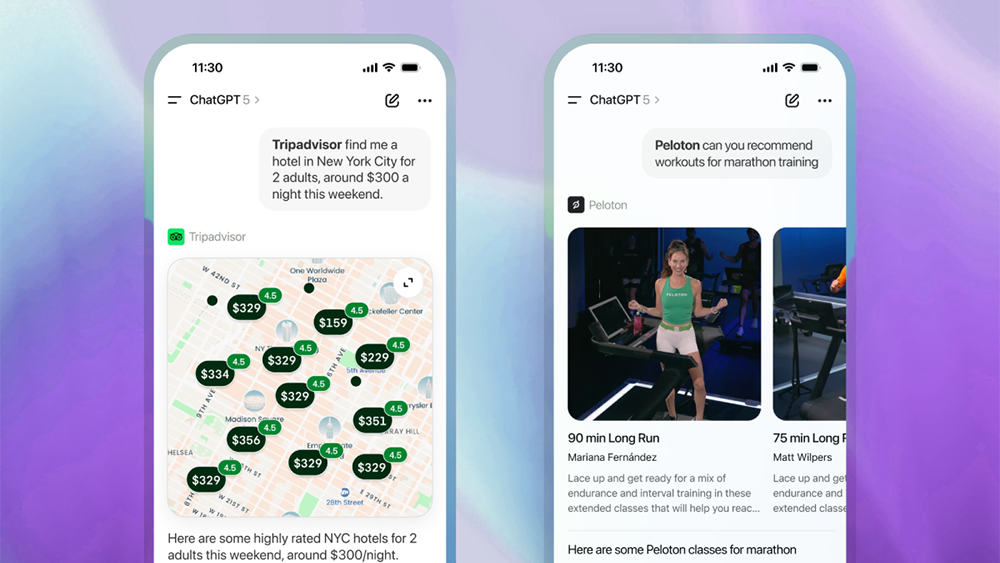
Key Points
- When Peloton noticed its members were exporting workout data into AI tools, the company realized that existing platforms did not give them a clear way to interpret or act on their metrics.
- Francis Shanahan, CTO at Peloton, explained how the company partnered with OpenAI to build a ChatGPT integration that supported emerging interface capabilities and real member use patterns.
- The project created a secure, low-risk technical model for turning raw data into practical recommendations and set the groundwork for a unified AI-driven experience.
When Peloton members started exporting their workout data into large language models to generate their own insights and recommendations, the company saw an opportunity. Instead of resisting the trend, Peloton leaned in, following the real user behavior of its most engaged community. The result is Peloton's integration with ChatGPT, an initiative that offers a model for navigating the move toward AI as a primary interface for consumer interaction by balancing hands-on innovation with unwavering member trust.
The strategy comes from the top. Francis Shanahan is Peloton's Chief Technology Officer, overseeing the entire connected fitness software stack across firmware, system software, service infrastructure, and applications. His career includes senior technology roles at major consumer brands including Nike with the SNKRS platform and Audible in its engineering leadership team. According to him, the recent ChatGPT integration reflects Peloton’s bet on a future where agents, browsers, and apps blend into one unified brand experience supported by AI.
"Twelve months from now, I see people using AI tools the same way they use a browser today. They will move fluidly between an agent, a website, and an app without thinking about the difference. From their standpoint, all of it will feel like one unified brand experience," said Shanahan. He framed the company's AI initiatives as a direct answer to a core problem in the wellness industry: from data overload to insight. Users have access to enormous amounts of data from wearables, but often lack the tools to synthesize it into actionable advice.
Signal from the noise: The AI integration acts as that missing synthesis layer. "What people often lack is a way to make sense of all that information. The challenge is pulling those metrics together, turning them into meaningful insights, and then translating those insights into concrete actions a person can take," Shanahan explained. Peloton sees this ability to turn raw data into practical guidance as the next phase of connected fitness, which inspired its recent introduction of Peloton IQ: a deep, personalized coaching system that delivers cardio and strength training guidance with adaptive plans, progress tracking, and real-time insights.

According to Shanahan, the project operated on a key principle: the experience only succeeds if the member feels fully in control while the technology fades into the background. That meant designing an OAuth flow that preserves user agency at every step and moves quietly behind the scenes, never interrupting the rhythm of planning a workout or exploring new classes.
Achieving flow state: Shanahan stressed that the experience only works if the technology disappears into the background. "When a user is in ChatGPT and issues a prompt that requires authentication, the system has to elevate the access and issue a new token in a way that feels completely natural. It cannot interrupt the moment or force people out of what they are doing. It just has to flow."
Consent is key: And trust, he insisted, depends on absolute clarity around data access and user control. "We make sure it's explicit what's being granted and what access is being given to the agent on the member’s behalf. People should always understand the choice they're making and feel comfortable with it. If we decide to expose more information in the future, it will only happen with the member’s explicit consent."
But the project didn't begin in a boardroom. Long before it became a strategic initiative, the idea lived as a quiet internal test, Shanahan said.
From couch to code: "The team rallied around this little germ of an idea and carried it from a hackathon project that started on my couch to something we could genuinely build on. I had been experimenting with MCP during our internal hackathon and sharing the idea with a few like-minded folks who immediately saw the potential. So when OpenAI approached us with a chance to pilot a new interface, the groundwork was already there, and we were ready to move," he explained.
Walk the walk: For Shanahan, leadership is something demonstrated through action rather than direction, and he believes the only way to stay ahead of emerging technology shifts is to model the same curiosity and experimentation he expects from his teams. "As the CTO, I'm the executive sponsor for our hackathons, but I always want to walk the walk, not just talk the talk. If my engineers are exploring, I get a chance to do that as well."
Peloton is one of only a small group of brands invited to build with OpenAI at this stage, and Shanahan sees that inclusion as both a recognition of the team’s technical depth—and a sign of how far the company has come in shaping the future of connected fitness. For him, the milestone is as much about engineering excellence as it is about member experience. "There's a very small set of brands that OpenAI is working with right now, and the fact that Peloton is among them is something we are incredibly proud of. Our team has been pushing the boundaries of what a fitness company can deliver, and seeing that work recognized on a global stage means a great deal," he concluded. "They make it easy to be proud because they are doing fantastic work every single day for our members."
.svg)





